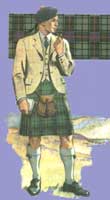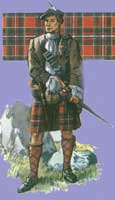Click below to find other Scottish Clans
|
|
|
The Davidson Clan is a Celtic one. They shared an ancestral homeland with the Cumins or Comyn. The Davidson clan are descended from it is believed a man called David Dubh and were led by this person to the relative safe haven of the Mackintosh clan., the Davidson's belong to Badenoch.
In the year1296, the Davidson's, the Mackintoshes and the Macphersons met together to wage a clan war upon the Cameron's in Invernahaven. There was a dispute of priority between the Macphersons and the Davidson's as to who would lead the family clans into the battle, and the Mackintoshes favoured the Davidson's. Enraged, the Macphersons left the field and the Cameron's won the battle. |
|
 |
Later, the Macphersons waged war upon the Cameron's and defeated them in turn, Years later, the Macphersons and Davidson's were, again, at loggerhead and it was arranged that thirty men from both sides should fight it all to the death in front of King Robert III. Only one Davidson survived and the clan has figured but very little in Scottish history since then.
It is a possibility that after this battle and the consequences of the defeat, that the family moved north and formed new families in places like Cantray and Tulloch. It is also recorded that the Davidson family were seen to be in the towns of Perth , Dundee and Aberdeen . They had been most often associated with the Aberdeen records. |
The best recorded being those of the alderman and Customar of Aberdeen (this was the Monarchs way of collecting Royal dues and taxes in the town) There was one man Robert Davisoun and another named David Filus in the civic records as having fought at the battle of Harlaw in the year 1411.
Henry Davidson the first Laird of Tulloch became a London Merchant and was extremely rich. Henry was succeeded by his brother Duncan who became a member of the British Parliament. Duncan was also a great favourite of Queen Victoria (The longest living Queen of Britain) and often went to stay with her when she visited Scotland . He became her Lord Lieutenant of Ross-shire. His castle at Tulloch was fully restored to its former beauty by the famous architect Sir Robert Lorimar.
Tulloch in Ross-shire became the home of the Davidson Clans Chief, he is also the hereditary Keeper of The Royal castle of Dingwall, and owned a small estate called Davidson in Easter Ross. At this moment in time a Davidson family member in New Zealand is seeking to matriculate Arms in the court of the Lord Lyon and claim Chiefship. of the Davidson clan.
|
Chief: Davidson of that Ilk or Tulloch
Clan Seat : Tulloch Castle , Dingwall; Cantray, Inverness
Plant: Cranberry |
|
|
| Back to Top |
Again, this is a family of Flemish origin who settled in Scotland during the days of King David I and they took their name from the lands of Douglasdale, in Lanarkshire, granted to them by King David, and witnessed in charter in the year of 1174 and again there was a charter in the year 1199..
During the Wars of Independence, this family sided with Robert the Bruce, and played a very great part in winning Scotland her freedom. The Douglas clan stood at Bannockburn on the twenty-fourth of June 1314,on the day that a vastly numerically superior English army was decimated by the Scots and Edward the second had to flee home to England . |
|
Sir James Douglas was one of the knights who made their way to Spain in order to take the heart of Robert the Bruce to a pilgrimage to Santiago the Compostella (the New Jerusalem). There, while fighting the Moors in 1330, Sir James died an heroic death when he charged at the overpowering force of the Moorish army in a suicidal bid to get his company free. His enemies applauded him and allowed his heart to be returned to his homeland for burial. His heart was later repatriated to Scotland and interred at Lee Castle by Simon Lockart of Lee.
Fighting on behalf of the French, the fourth Earl of Douglas was created ‘ Duke of Touraine ' in 1424, only to die a few days later at the battle of Verneuil against the English forces.
Tracing an ancestry from the second wife of King Robert II, their claiming the Stewart Crown made them enemies in the eyes of Scotland 's royal house. The Sixth Earl of Douglas (third Duke of Touraine) and his brother David were invited in 1440 by the keeper of Edinburgh Castle to attend a dinner with the boy-King, James II. Both were beheaded after the meal. The seventh Earl himself would be later killed by James II himself at Stirling Castle in the year of 1452. The last Earl was forfeited in 1455 and died a monk at Lindores in 1488.
George Douglas married a Stuart Princess and became very affluent and had great prominence in Scotland 's society. He was the first of the Red Douglases.
Mary, Queen of Scots, also held the Douglas land of Touraine as Dauphiness and then Queen-dowager of France . Her second husband, Henry Stewart, Lord Darnley, was the son of Lady Margaret Douglas, daughter of Archibald Douglas, bell the cat, and Margaret Tudor, Princess of England.
|
Chief: Douglas of Douglas
Clan Seat: Douglas Castle, Lanarkshire; Tantallon Castle , East Lothian
Plant: None
Memorials: St. Brydes Kirk, Douglas |
|
| Back to Top |
Malcolm Beg, Lord of the lands of Drummond and Seneschal, and Seneschal of Strathearn in 1225, He is the progenitor of the clan. His descendants owned the lands of Drummond outright by 1499. Annabella Drummond of Stobhall married Robert III of the Scots' and became his Queen. The name Drummond is based on the name of the town Drymen, Stirlingshire.
The Drummonds have always been faithful to the Stewarts and James Drummond fourth Earl of Perth, was Lord Chancellor of Scotland. James VIII of the Scots (third of England ) created him ‘ Duke of Perth '. The second Duke was ‘out' on behalf of the Stewarts during the 1715 rising and was attainted by George I. |
|
 |
James Drummond was one of the first in Scotland to join the Jacobite cause in 1715 and had a very cunningly devised a plan to take Edinburgh Castle . Due to circumstances beyond his control the plan did not do the job it was supposed to. At the battle of Sheriffmuir he was in command of the Jacobite Horse.
After the Jacobite struggle had been side lined again James managed to escape to France . His lands were declared forfeit to the Crown. The Drummonds were ready again for the Jacobite cause and were
waiting patiently to welcome Charles Edward Stuart (Bonnie Prince
Charlie) when he arrived in Scotland in 1745. |
The clan fought bravely at Culloden on the left flank and when the bloody battle was over and the Government wanted revenge on the righteous Jacobites his lands were was more forfeit and he had to flee to France for his life, unfortunately the trip was a harrowing one and he died trying to get to freedom..
His line died out with the deaths of his two unmarried sons and the title then passed to two cousins of theirs descended from the first Duke. That line, however, died out as well and the right to the Earldom of Perth passed into the Melfort Drummond family.
In the year 1853, George Drummond Duc de Melfort, Comte de Lussan and Baron de Valrose in the peerage of France was restored by act of parliament to the title ‘ Earl of Perth '
The sixteenth Earl of Perth was the first secretary of the ‘ United Nations'
George, however, died without a son and was succeeded by his daughter, Lady Mary Drummond, who carried on the Melfort title. The Earldom of Perth devolved upon his kinsman William Drummond, eleventh Viscount of Strathallan.
The Drummond chiefs are also Barons of Cargill and Stobhall.
|
Chief : Earl of Perth
Clan Seat : Castle Drummond, Crief; Stobhall, Perthshire
Plant: Holly
Memorials: None |
|
| Back to Top |
This family goes back to the days of King William the Lion of the Scots and Serle de Dundas is the ancestor of all the Dundases. His name appears in charters in the late twelfth century. There is a saying ‘ Any prime Minister can raise a man to the House of Lords but it takes seven centuries of Scottish history to make one Dundas of Dundas'
Sir Archibald Dundas was employed many times by James the third to go on secret missions down south to England for him. The new king James the fourth did bestow honour on the Dundas Family clan by awarding them the beautiful island home Inchgarvie and with the provision that they could build a castle there if that was their choice. |
|
The eighteenth laird of the Dundas family was a staunch Presbyterian and he had fought in the wars of the Covenant. He was also on the committee for the trial of the legendary great Scot the ‘Marques of Montrose'.He was also given the command of the area known as Linlithgow and was told to keep the place safe against the raids of Oliver Cromwell.
From earliest times the Dundases played a prominent role in the affairs of Scotland ; most remarkable was the legal dynasty beginning with Sir James, 1st Lord Arniston who died in 1679. His grandson Robert held the posts of Solicitor General, Lord Advocate and Lord President; he was succeeded by his son who, as Lord Arniston, was a judge. His son, like him called Robert, was Solicitor General in 1784,
The twenty-third laird of Dundas , who worked for the East India Company. was on a boat near or going to Madagascar in 1792 when his ship ran into problems which sank her and he went down along with all the rest of the crew
Alexander Dundas, of the Fingask line, fell at Flodden fighting the army of Henry VIII with King James IV. The statesman Henry Dundas was known as "the uncrowned King of Scotland" and "managed" Scotland for William Pitt. Through his offices many estates forfeited after the 1745 rebellion were restored and the ban on the wearing of tartan was lifted. Arniston House at Gorebridge is owned by the Dundas family. Dundas Castle near South Queensferry was built by James Dundas of that Ilk in 1424. In the 15th century the Dundas family garrisoned Inchgarvie Island in the Firth of Forth having been given special permission to do so by James IV. The present chief, David Duncan Dundas of Dundas , lives in South Africa . As well as the Marquisate of Zetland, dating back to 1838, other branches of the family are those of Newliston, Duddingston and Manour. From Robert Dundas, Lord President of the Court of Session, are descended the Melville Dundases. The Barony of Dundas of Aske was created in 1794.
|
Chief: Dundas of Dundas
Clan Seat: Dundas castle, South Queensferry ; Inchgarvie, in Firth of Forth
Plant: Bilberry
Memorials : None |
|
Click below to find other Scottish Clans
|
|
Back to Top
|